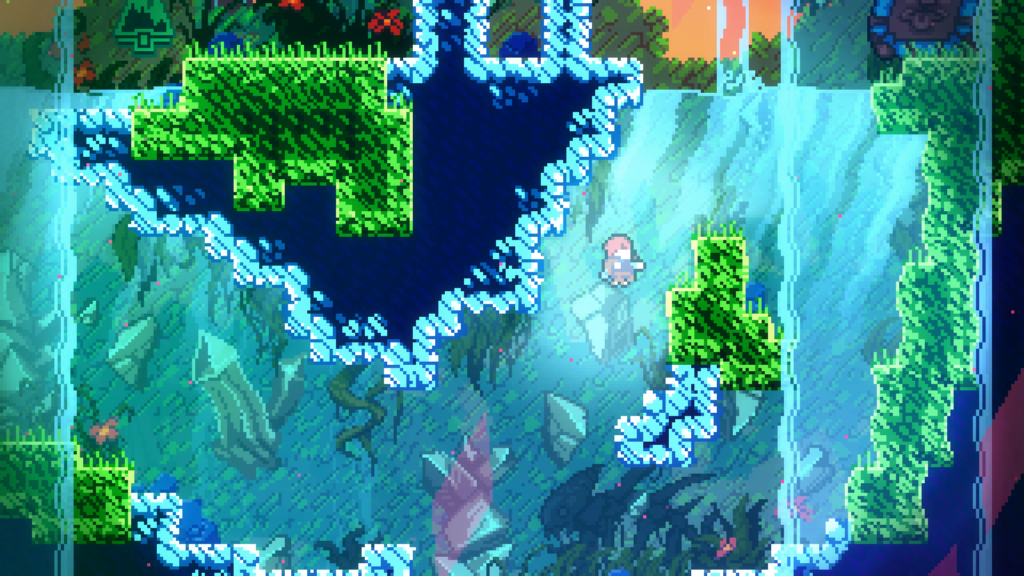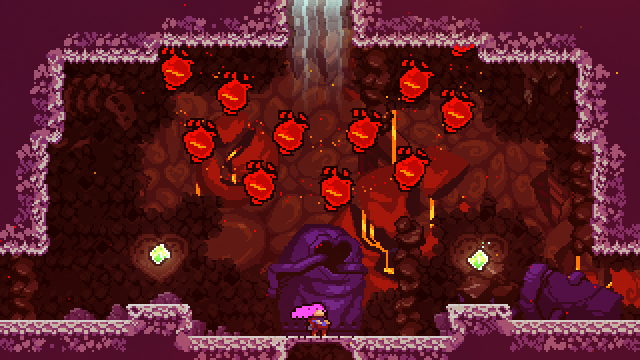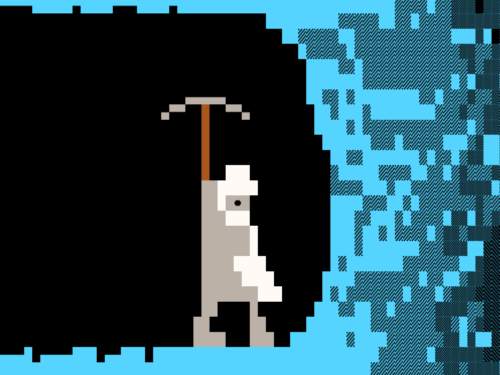From the first note of Celeste’s phenomenal soundtrack, I was completely enveloped into the game’s world and the mystery surrounding it. The 8-bit adventure opens with Madeline, our hero, setting out to climb Mt. Celeste. Her seemingly simple quest is brought into question when she meets Granny, a mysterious old woman who lives alone on the titular mountain. Granny warns Madeline that there are surprises in store and makes players wonder why Madeline’s is actually climbing the mountain. Subtle clues tell us that the climb is more than a physical journey, and she might not be the archetypal self-assured hero.
This gives players room to think about her possible background and what drives her, telling them just enough to run wild with. It’s the kind of storytelling that has made games like Dark Souls and Bloodborne so engrossing, focusing more on the location than the narrative. Madeline meets colorful characters, like Mr. Oshiro, the unsettling hotel owner, and Theo, the aspiring photographer who seems more concerned about pleasing his InstaPix followers than adapting to the dangers of Mt. Celeste.
Every level is punctuated by Madeline facing the darkest parts of her psyche, personified by an evil “Part of Her” that actively discourages her from continuing up the mountain. It’s a tasteful way to explore anxiety and depression that lets players inside her head. The metaphor is heavy-handed at times, but the subtle interactions are where this story shines.
Early in the game Madeline has two very different interactions during panic attacks. During the first, one person tells her that she needs to calm down; the second tells her that everything’s going to be OK. It’s moments like these that show anxiety and depression are complex feats to overcome — more than just feeling sad or nervous. Thankfully, overcoming her anxiety and Mt. Celeste never feel impossible. With the help of some fantastic controls, Madeline can surpass any challenge presented to her, big or small.
Celeste’s movement is tight. Madeline moves at a realistic pace for her character but isn’t sluggish or too loose. This is a game that actually allows players to play how they want — whether fast and efficient or slow and methodical, both strategies are rewarded. Developer Matt Makes Games has built upon classic platformer elements, but as new obstacles are introduced, the game grows progressively more difficult through its eight chapters. Use of momentum, holding on to small ledges for safety and flinging oneself into the unknown are all feats players will have to accomplish to reach Celeste’s summit.
Early on, players are introduced to moving platforms that activate when landed upon, and jumping off at the right time propels them to a wall that was previously unreachable with Madeline’s jump and dash abilities. Dashing is a useful tool that’s easy to lean on as a crutch, but in the more challenging middle chapters that strategy is swiftly punished. A visual cue tells players when the dash is usable by turning Madeline’s hair from red to blue. It’s a nice touch that doesn’t necessitate a distracting heads-up display.

The “enemies” of the game are Madeline’s “Part of Her,” Mr. Oshiro and assorted monsters that are introduced toward the game’s conclusion. Unlike your typical enemies, Madeline cannot hurt them, but they can attack her. This might seem unfair, but it works, because rather than adding an unnecessary combat mechanic, the developers focused on making the platforming work. Boss battles, or rather boss chases, force players to think quickly and act quicker.
With the introduction of Madeline’s “Part of Her,” the game’s first, and also, final boss, players have to use their entire repertoire to reach safety. It’s a test of skill and patience, but also introduces one of the game’s major flaws. After being able to move at whatever pace suits the player, these chase sequences are a sharp contrast because the pace is decided by the boss, rather than the player. It’s a minor issue, but in a game that’s so well-crafted, these sudden shifts in style are hard to ignore.
In spite of any minor gripes, I haven’t played a platformer that felt this focused in a long time. Every jump, dash, grapple and fall feels so deliberately planned it’s astonishing that the game was created by just a few developers. There’s an attention to moment-by-moment detail that just isn’t seen in AAA gaming.
It’s easy to disregard modern games that use an 8-bit style as slaves to a trend, but here the style never overtakes the substance. Celeste is retro in appearance but forward-thinking in practice. Rather than tap into nostalgia, it puts having a new experience and a beautiful aesthetic first. Celeste’s every frame is full of color. The mountain’s various areas have different color schemes that match the mood of each level and reinforce the themes of the cut-scenes. From the dark resort level, utilizing a mix of purples and reds, to the valley level in Chapter 6 that has a brighter mix of greens and blues, the mix of colors and styles are as memorable as the gameplay.
Celeste is more than just a good indie game — it’s an experience. It was surprising, challenging, a ton of fun and stuck with me after completion. The story is bittersweet and one that could resonate with anyone, regardless of if they’ve struggled with depression. At its core, Celeste reminded me of what makes a classic game, and Matt Makes Games have made just that.
(Split Tooth may earn a commission from purchases made through affiliate links on our site.)




